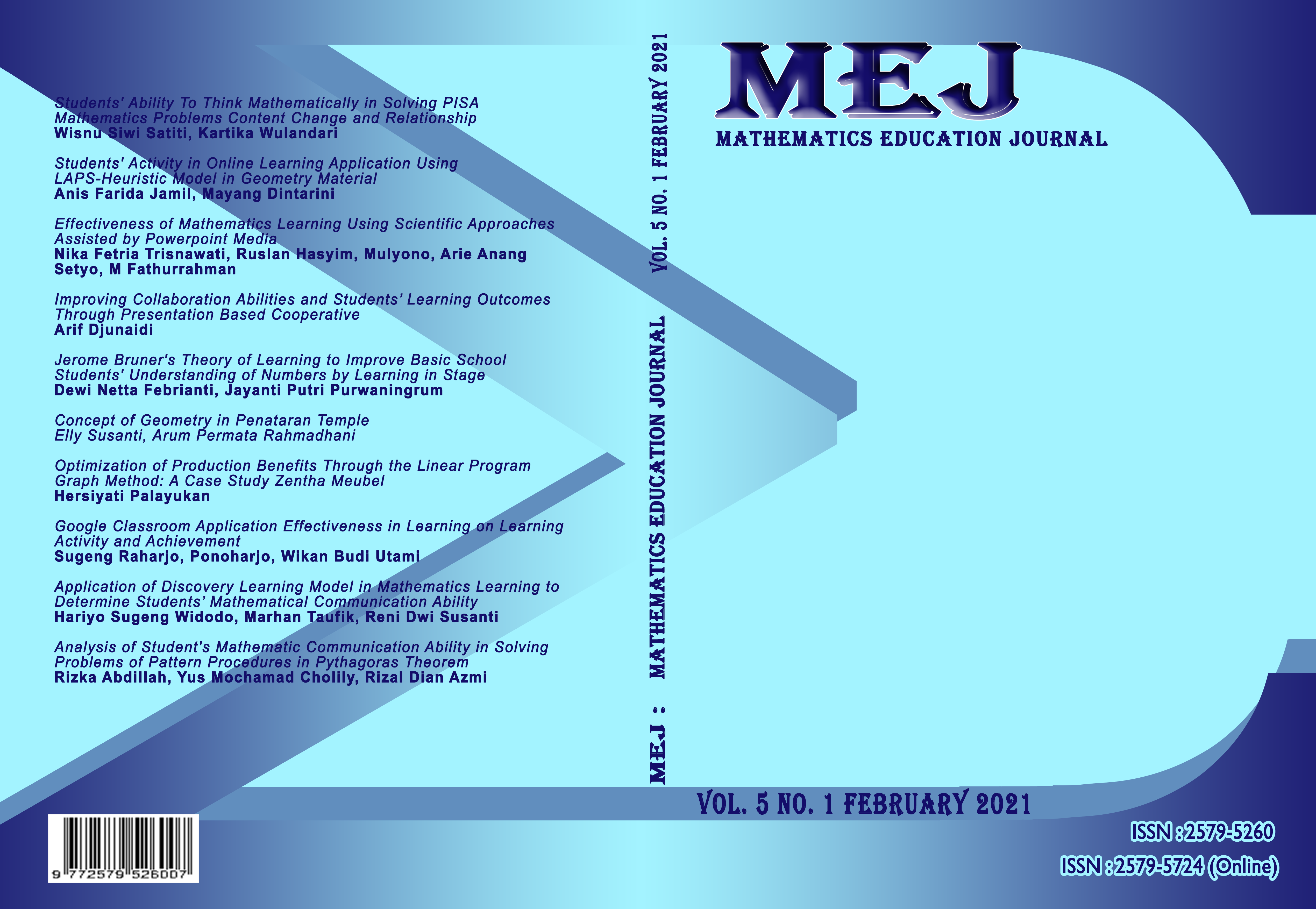The Concept of Geometry in Penataran Temple
DOI:
https://doi.org/10.22219/mej.v5i1.15545Abstract
This study aims to describe the results of exploring the shapes in Penataran Temple, cultural relics accompanied by geometric concepts. This research uses explorative-descriptive research because it is suitable for uncovering mathematical cases related to Ethnomathematics. The data analysis technique used in this research is qualitative. In this study, an ethnographic approach was used, accompanied by interviews, collecting documentation, or analyzing literature about Penataran Temple as data collection techniques. This study concludes that the relationship between culture and building structure in Penataran Temple has always been attached to the concept of geometry in the material. Wake up flat and build space. In these buildings, the forms are applied in mathematical objects such as in flat plane geometry and space shapes. As in this study results, there are several structures, namely cuboid and right triangular prism and plane shape, in an isosceles triangle.
Downloads
References
Andika Arisetyawan, Didi Suryadi, Tatang Herman, C. R. (2014). Study of Ethnomathematics : A lesson from the Baduy Culture. International Journal of Education and Research, Vol. 2, No.
Aditya Bayu Perdana & Rahadhian P. Herwindo. (2020). Study on Architectural Relation of Ancient Mataram Hindu Candi and Vāstuśāstra. Jurnal RISA (Riset Arsitektur), 4(3), 234–251.Buchori A, Sudargo, Rahmawati ND, B. M. (2016). Digital Media Development of Math Game with Ethnomathematics Model Based on Javanese Local Wisdom in Higher Education. Arts and Social Sciences Journal, 7(4).
Edi Sedyawati, Hariani Santiko, Hasan Djafar, Ratnaesih Maulana, Wiwin Djuwita Sudjana Ramelan, C. A. (2013). Candi Indonesia: Seri Jawa: Indonesian-English. Jakarta: Direktorat Jenderal Kebudayaan.
Fatya Permata Anbiya, dkk. (2014). Kamus Besar Bahasa Indonesia Edisi Kelima. In Badan Pengembangan dan Pembinaan Bahasa Kementerian Pendidikan dan Kebudayaan Republik Indonesia.
Lestari, G. (2007). Mengenal lebih dekat : Candi Nusantara. Jakarta: Pacu Minat Baca.
Morquecho, A., Vicente, A. S., Laya, R., & Ventura, T. (2009). New 3D micro-CMM triplanar simetry design concept. Proceedings of the 9th International Conference of the European Society for Precision Engineering and Nanotechnology, EUSPEN 2009.
Niken Wahyu Utami, Suminto A Sayuti, J. (2019). Math and Mate in Javanese Primbon: Ethnomathematics Study. Journal on Mathematics Education, Vol. 10, N, 341–356.
Pusat Data dan Analisa Tempo. (2019). Menyaksikan Kemegahan Candi Hindu Yang Tersebar Di Pulau Jawa. Jakarta: Tempo.
Rahadian PH. (2008). Kajian Perkembangan Desain Arsitektur Bangunan Sakral Hindu-Budha di Jawa Transformasi dan Adaptasi dalam Arsitektur pada Masa Islam di Jawa (Tradisional Jawa). Research Report - Engineering Science.
Supriadi. (2016). Pembelajaran Etnomatematika Sunda dalam Memelihara Budaya Bangsa. Serang: PGSD UPI Kampus Serang.
Yoyok & Siswandi. (2007). Pendidikan Seni Budaya. Yudhistira.
Downloads
Published
Versions
- 2021-03-19 (2)
- 2021-03-18 (1)
Issue
Section
License
Copyright (c) 2021 Elly Susanti

This work is licensed under a Creative Commons Attribution-ShareAlike 4.0 International License.
Authors who publish with MEJ (Mathematics Education Journal) agree to the following terms:
For all articles published in MEJ, copyright is retained by the authors. Authors give permission to the publisher to announce the work with conditions. When the manuscript is accepted for publication, the authors agree to automatic transfer of the publishing right to the publisher.
Authors retain copyright and grant the journal right of first publication with the work simultaneously licensed under a Creative Commons Attribution-ShareAlike 4.0 International License that allows others to share the work with an acknowledgment of the work's authorship and initial publication in this journal.
Authors are able to enter into separate, additional contractual arrangements for the non-exclusive distribution of the journal's published version of the work (e.g., post it to an institutional repository or publish it in a book), with an acknowledgment of its initial publication in this journal.
Authors are permitted and encouraged to post their work online (e.g., in institutional repositories or on their website) prior to and during the submission process, as it can lead to productive exchanges, as well as earlier and greater citation of published work (See The Effect of Open Access).

This work is licensed under a Creative Commons Attribution-ShareAlike 4.0 International License.










